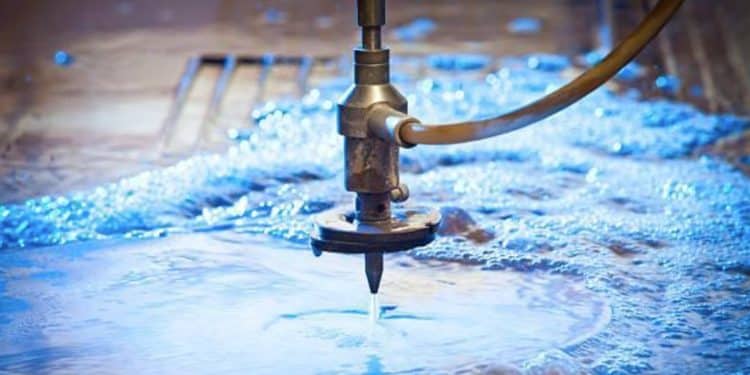Waterjet cutting technology is a process that uses high-pressure water to cut through materials. The technology has been in use for more than 50 years and is used in a variety of industries, including manufacturing, automotive, and aerospace. Waterjet cutting is a versatile technology that can be used to cut a wide range of materials, including metals, plastics, and composites.
In addition, the technology can be used to create complex shapes and elements that are difficult or impossible to produce with other methods. Waterjet cutting technology is becoming more prevalent in the construction industry. Here’s a look at how it’s being used and some of the types it offers.
Abrasive Waterjet
Abrasive waterjet is a cutting process that uses high-pressure water to erode material from a workpiece. The water is mixed with an abrasive material, such as garnet or aluminium oxide, which gives the waterjet its cutting power. Abrasive waterjet can cut almost any material, including metal, stone, glass, and plastics. It is often used for cutting intricate shapes or for making smooth, finished cuts without the need for secondary machining operations. Abrasive waterjet also has the advantage of being a cold cutting process, which means it does not create heat-affected zones (HAZ) in the material. This makes it ideal for cutting heat-sensitive materials, such as titanium or stainless steel.
Abrasive Waterjet (AWJ) is an effective technology used in a wide variety of construction applications. It uses a high-pressure waterjet to cut through material, making it an ideal choice for cutting hard or brittle materials like cutting granite with a Waterjet Cutter. The technology can be used for a variety of applications, including cutting concrete, stone, metal, and glass. In addition, AWJ can be used for engraving or marking surfaces. The versatility of this technology makes it a valuable tool for construction professionals. For example, it can be used to create custom designs on walls or floors or to cut materials to precise specifications. In addition, the technology is safe and environmentally friendly, making it an excellent choice for eco-friendly construction projects.
Pure Waterjet
Pure waterjet is a technology that uses high-pressure water to cut through materials. It is an environmentally friendly alternative to traditional cutting methods, such as plasma and laser cutting, which use harmful chemicals and generate hazardous waste. Pure waterjet can cut through a wide range of materials, including metals, stone, glass, and plastics. It is also capable of creating highly intricate designs and can be used for both prototyping and production applications. In recent years, pure waterjet has become increasingly popular for a variety of applications, due to its versatility, precision, and environmental friendliness.
Jetting with pure water is a construction process that uses pressurized water to remove dirt, graffiti, paint and other unwanted materials from surfaces such as concrete, brick and stone. The high-pressure stream of water loosens and breaks up the material, which is then rinsed away with a lower-pressure stream of water. Jetting with pure water is a safe, effective and environmentally friendly way to clean construction surfaces. It does not require the use of harsh chemicals or solvents, and it produces no harmful waste products. In addition, jetting with pure water can be used on both interior and exterior surfaces, making it an ideal solution for a wide range of construction cleaning applications.
Air-Assisted Waterjet
Air-assisted waterjet is a technology that uses a high-pressure stream of water to cut through materials. The water is typically mixed with an abrasive material, such as sand, to help the cutting process. Air-assisted waterjet is often used for industrial applications, such as cutting metal or stone. It can also be used for more delicate tasks, such as engraving. Air-assisted waterjet is a versatile technology that offers many benefits over traditional cutting methods. It is extremely precise and can be used to cut through material that would otherwise be difficult or impossible to cut with conventional methods. Additionally, air-assisted waterjet is much quieter than traditional methods and produces minimal vibration, making it ideal for use in sensitive environments.
Air-assisted waterjet technology is often used in construction and demolition applications. The high-pressure stream of water can cut through many materials, including concrete and metal. This makes it an ideal tool for breaking up large chunks of debris or removing old layers of paint or wallpaper. In addition, the air-assisted waterjet can be used to clean surfaces before painting or construction. The high-pressure stream of water loosens dirt and grime, making it easy to wash away. As a result, air-assisted waterjet technology offers a versatile and effective solution for many construction and demolition applications.
Cavitation-Free Waterjet
Cavitation is a phenomenon that can occur when water flows through a narrow opening at high speed, such as the nozzle of a waterjet. When cavitation occurs, the water vaporizes, creating tiny bubbles. These bubbles then collapse, creating a destructive force that can erode materials. Cavitation can also cause the waterjet to lose thrust and become less efficient. As a result, manufacturers have developed cavitation-free waterjet technology, which uses specially designed nozzles to prevent cavitation from occurring. This allows the waterjet to operate at higher speeds and with greater efficiency, making it an ideal tool for cutting and machining applications.
Cavitation-free waterjet (CFWJ) machines use high-pressure water to cut through materials without the use of abrasives. The technology is often used in the construction industry for a variety of applications, including cutting stone, concrete, and metal. CFWJ machines are also becoming increasingly popular for use in sensitive environments, such as food processing plants and hospitals, where there is a need to minimize potential contamination. In addition, CFWJ technology offers a number of advantages over traditional methods, such as improved accuracy and reduced noise levels. As a result, it is likely that the use of CFWJ machines will continue to grow in the construction industry in the years to come.
Oxygen-Enhanced Waterjet
Sitting at the dentist’s office, you may have seen a small, hand-held waterjet with a clear plastic tube attached. This is an oxygen-enhanced waterjet, and it is used to remove plaque and bacteria from teeth. The jet fires a stream of pressurized water that is mixed with oxygen. The oxygen helps to kill bacteria and break down plaque. The oxygen-enhanced waterjet is a safe and effective way to clean teeth, and it can be used on both adults and children. The jet can also be used to remove food particles from between teeth. If you are looking for a gentle and effective way to clean your teeth, consider using an oxygen-enhanced waterjet.
Applying oxygen-enhanced waterjet (OEWJ) technology in construction is an exciting development that holds great promise for the future. OEWJ technology uses high-pressure water jets to cut through materials, but with the addition of oxygen to the mix, it is possible to achieve significantly higher cutting speeds. This makes OEWJ an ideal tool for a range of construction applications, from cutting through concrete to removing metal fixtures. In addition, the use of oxygen also allows for more precise and controlled cuts, making OEWJ an excellent choice for delicate or difficult projects. With its many potential uses, it is clear that OEWJ technology is poised to play a major role in the future of construction.
In Conclusion
So, what’s the best waterjet for you? It depends on your needs and budget. If you’re looking for a versatile machine that can handle a wide range of materials, an abrasive waterjet is probably your best bet. But if you’re looking to save money and don’t mind sacrificing some versatility, a pure waterjet or air-assisted waterjet may be right for you. And if you need to cut particularly tough materials or want to take advantage of the benefits of cavitation-free cutting, an oxygen-enhanced waterjet is the way to go. No matter which type of waterjet you choose, we hope this article has helped make the process of selecting one a little less daunting.
David Prior
David Prior is the editor of Today News, responsible for the overall editorial strategy. He is an NCTJ-qualified journalist with over 20 years’ experience, and is also editor of the award-winning hyperlocal news title Altrincham Today. His LinkedIn profile is here.












































































